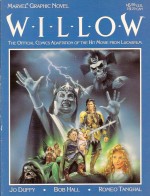
By Morris & Goscinny, translated by Luke Spear (CineBook)
ISBN: 978-1-905460-12-0
It’s hard to think of one of Europe’s most beloved and long-running comics characters being in any way controversial, but when the changing times caught up with the fastest gun in the West (“so fast he can outdraw his own shadowâ€) and the planet’s most laconic cowboy moved with them, the news made headlines all over the world.
Lucky Luke is a rangy, good-natured, lightning fast cowboy who roams the fabulously mythic Old West, having light-hearted adventures with his horse Jolly Jumper and Rantanplan (“dumbest dog in the West†and a charming spoof of cinema canine Rin-Tin-Tin), interacting with a host of historical and legendary figures of the genre.
His continued exploits over more than 66 years have made him one of the best-selling comic characters in Europe, (78 collected books and more than 300 million albums in 30 languages thus far), with spin-off games, computer games, animated cartoon and even a plethora of TV shows and live-action movies.
He was created in 1946 by Belgian animator, illustrator and cartoonist Maurice de Bévère – AKA Morris – for the 1947 Annual (L’Almanach Spirou 1947) of Le Journal de Spirou, launching into his first weekly adventure ‘Arizona 1880′ on December 7th 1946.
Before then, while working at the CBA (Compagnie Belge d’Actualitiés) cartoon studio Morris met future comics super-stars Franquin and Peyo, and worked for weekly magazine Le Moustique as a caricaturist (to my eyes Lucky Luke looks uncannily like the young Robert Mitchum who graced so many mid-1940s B-movie Westerns).
He quickly became one of “la Bande des quatreâ€, or Gang of Four, which comprised the creators Jijé, Will and his old comrade Franquin, and who were the leading proponents of the loose and free-wheeling artistic style known as the “Marcinelle School†which dominated Spirou in aesthetic contention with the “Ligne Claire†style used by Hergé, EP
Jacobs and other artists in Tintin Magazine.
In 1948 the Gang (all but Will) visited America, meeting US creators and sightseeing, and Morris stayed for six years, meeting René Goscinny, scoring some work from the newly-formed EC sensation Mad and making copious notes and sketches of the swiftly vanishing Old West. That research would resonate on every page of his life’s work.
Working alone until 1955 when he reunited with Goscinny, Morris produced another nine albums worth of affectionate sagebrush parody before, working in perfect unison, Luke attained the dizzying heights of superstardom, commencing with ‘Des rails sur la Prairie’ (Rails on the Prairie), which began in Spirou on August 25th 1955.
In 1967 the straight-shooter switched teams, transferring to Goscinny’s own magazine Pilote with ‘La Diligence’ (The Stagecoach). Goscinny produced 45 albums with Morris before his death, from when Morris continued both alone and with fresh collaborators.
Morris died in 2001 having drawn fully 70 adventures, plus the spin-off adventures of Rantanplan, with Achdé, Laurent Gerra, Benacquista & Pennac taking over the franchise, producing another five tales to date.
Moreover, apart from that very first adventure Lucky, to appropriate a quote applied to the thematically simpatico Alias Smith and Jones “in all that time he never shot or killed anyoneâ€â€¦
Lucky Luke first appeared in Britain syndicated in the weekly comic Film Fun and again in 1967 in Giggle where he was renamed Buck Bingo. In all these venues as well as the numerous attempts to follow the English-language successes of Tintin and Asterix albums from Brockhampton and Knight Books, Luke had a trademark cigarette hanging insouciantly from his lip, but in 1983 Morris – no doubt amidst both pained howls and muted mutterings of “political correctness gone mad†– substituted a piece of straw for the much-travelled dog-end, which garnered him an official tip of the hat from the World Health Organization.
The most recent attempt to bring Lucky Luke to our shores and shelves comes from Cinebook, with Ghost Town the second of the 28 (and counting) available albums, originally collected in 1965 as La Ville fantôme, the 25th adventure and Goscinny’s 16th collaboration with the artist.
As Luke rides the range he encounters two tarred-and-feathered gamblers Denver Miles and Colorado Bill. Despite instantly assessing their scurrilous natures – and of course they do try to rob him – he gives them assistance and a ride to the nearest outpost of civilisation.
That happens to be the deserted mining town of Gold Hill where they encounter an embittered old miner dubbed Old Powell who chases them off at gunpoint.
A little further on they reach Bingo Creek where they discover the mad old coot was once the victim of a gold-salting scheme (hiding gold on worthless land and getting a sucker to buy it) but stubbornly refused to quit, convinced that somewhere in his mountain the motherlode still lay hidden…
Denver and Colorado are incorrigible crooks and after Lucky exposes their fleecing of the townsfolk the bent gamblers try to backshoot him, only to fall foul of Powell’s skill with a rifle…
Eternally grateful Lucky determines to befriend and assist the irascible old coot, despite his surly protests, whilst Denver and Colorado plan the perfect revenge by attempting to steal his mine and then re-salt it before selling it to some other sucker…
To this end they try buy up the claim, have Old Powell hanged for witchcraft, frame him for cattle-rustling and even plant the stolen cash-register from the saloon in his mine.
But they haven’t reckoned on the ingenuity of Lucky Luke; a man so swift and sharp that he can outdraw his own shadow… Against the masterful wits and wicked wits of our indomitable hero the gamblers are ultimately helpless in this splendidly intoxicating blend of all-ages action, slapstick and wry cynical humour.
Although the dialogue is still a bit dry in places, this is a grand old hoot in the tradition of Destry Rides again and Support Your Local Sheriff (or perhaps Paint Your Wagon, Evil Roy Slade or Cat Ballou are more your style?) superbly executed by master storytellers and a wonderful introduction to a unique genre for modern kids who might well have missed the romantic allure of the mythical Wild West.
And in case you’re worried, even though the interior art still has our hero chawin’ on that ol’ nicotine stick, trust me, there’s very little chance of anyone craving a quick snout, but quite a high probability that they’ll want more Lucky Luke Albums…
© Dargaud Editeur Paris 1971 by Goscinny & Morris. © Lucky Comics. English translation © 2006 Cinebook Ltd.











